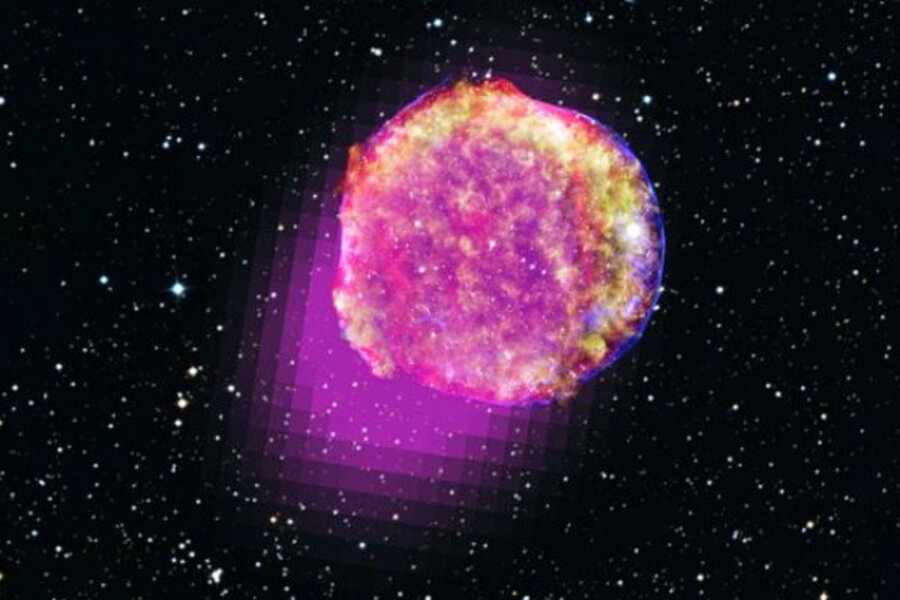Scientists probe mysterious origins of humongous star explosions
Loading...
The most powerful exploding stars in the universe are still cloaked in mystery, but some are now yielding the secrets of their origins, scientists say.
Research is also shedding light on gamma-ray bursts, the most powerful explosions in the universe, up to a million times brighter than a supernova, scientists added.
The most powerful star explosions are supernovas, which are bright enough to briefly outshine all the stars in their galaxies. There are two known ways supernovas occur — a Type Ia supernova arises when one star piles fuel onto a dying star known as a white dwarf, and a Type II supernova happens when the core of a massive star runs out of fuel, collapses to an extraordinarily dense nugget in a fraction of a second and then bounces and blasts its material outward.
In the past 12 years, scientists have detected a new class of supernovas, ones about two to 100 times brighter than all the others. These so-called super-luminous supernovas apparently come in three different flavors, only one of which is well-understood. [Amazing Supernova Photos]
The rarest but seemingly best-understood of these super-luminous, or super-bright, supernovas are the radioactively powered SLSN-R. These supernovas seem to arise from the collapses of stellar cores, and apparently also each involve huge amounts of a radioactive isotope of nickel in those dying stars, enough to equal several times the mass of the sun. As this radioactive material decays, it releases energy in the form of gamma rays and antimatter that makes the expanding material from the supernova glow.
The way this radioactive nickel is created remains hotly debated. One possibility is that it gets forged during the collapse of stellar cores; the other is that it is created in nuclear reactions involving oxygen in very massive stars, said study lead author Avishay Gal-Yam, an astrophysicist at the Weizmann Institute of Science in Rehovot, Israel.
Probably the most observed type of super-luminous supernova is the hydrogen-rich SLSN-II. They apparently typically emerge from stars that possess thick hydrogen envelopes, which veil their light and make it difficult to say what causes these explosions. They may get the boost in brightness from a number of culprits, such as newly formed black holes, which rapidly suck matter into themselves, or magnetars, which are rapidly spinning neutron stars with powerful magnetic fields — either of these possibilities might disrupt the hydrogen tremendously, with luminous effects.
"SLSN-II are technically Type II supernovae, but are unlikely to be the same as common Type II supernovae that come from exploding red supergiant stars," Gal-Yam said. "The properties of SLSN-II cannot be matched by any red supergiant we know — they must have different progenitors."
The hydrogen-poor SLSN-I are the most luminous of all known supernovas. Although these supernovas are not surrounded by massive, opaque hydrogen envelopes, their origins remain deeply uncertain.
"They are indeed mysterious," Gal-Yam said.
One possibility is that they are hydrogen-poor stars that had inflated to very large diameters, dozens of times larger than our sun's. When they went supernova, they would radiate brightly and for a long time, but not be surrounded by much of a hydrogen envelope.
"The other option people have looked into is to have a more normal hydrogen-poor star which is only a few times larger than the sun — such stars are known in our galaxy and called Wolf-Rayet stars — and then pump it up with magnetic energy drained from an object called a magnetar, which is a rapidly rotating and highly magnetized neutron star, that was formed in the core of this Wolf-Rayet star when its core collapsed," Gal-Yam said. "The mystery here is that while we know that magnetars exist — we see them in our galaxy — it is not clear they rotate rapidly enough when they are born inside stars to power up such super-supernovae."
Investigating super-luminous supernovas can help better understand how heavy elements were created, "especially in the early universe," Gal-Yam told SPACE.com. In addition, "they are very bright and can serve as beacons, illuminating faint and obscure tiny dwarf galaxies at high redshifts — very far away, so the light was emitted a long time ago — allowing us to study [smyers1] the very early universe."
Gal-Yam detailed this research on super-luminous supernovas in a paper appearing in the Aug. 24 issue of the journal Science, in tandem with a second paper on the nature of gamma-ray bursts. That second paper revealed that data from the Swift and Fermi satellites support theories that the bursts are powered by cataclysmic stellar events leading up the formation of a black hole.
Follow SPACE.com on Twitter @Spacedotcom. We're also on Facebook and Google+.
Copyright 2012 SPACE.com, a TechMediaNetwork company. All rights reserved. This material may not be published, broadcast, rewritten or redistributed.







